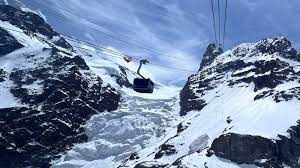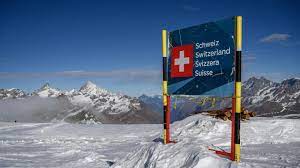Italy: How climate change is redrawing the border between Switzerland

Rome: Land borders are often regarded as permanent fixed lines – but in mountainous regions like the Alps, where melting glaciers and permafrost are reshaping the landscape, sometimes local authorities are forced to redraw the map.
“- Merci,” “- Merci.” At the arrival of the cable car at Testa Grigia (3,458 metres), people often exchange courtesies in French.
We are on the Swiss-Italian border, just above the Theodul glacier, which unites residents in a shared economy, alongside their knowledge of the French language.
At least for now, the two municipalities around the iconic Matterhorn mountain are thriving due to the steady flow of tourists coming to visit the beauties of the region and ski on its high-altitude slopes, which are covered in snow throughout the year.
On the Swiss side, the resort of Zermatt is outperforming Switzerland’s growth, while Cervinia on the Italian side is doing better than most of Italy.
This is despite the glacier’s melting, which has modified the landscape, pushing local authorities to redefine the border between the two countries.
“The glacier has shrunk on the Italian side. In some areas, there is only land left,” said Jérôme Perruquet, a mountain guide from the Aosta Valley.
The extent of the glacier’s melting on the Italian side has made it necessary to do some consolidation works, which are due to start soon, Perruquet said.
“The Swiss will lead them because, although largely on Italian territory, they have the biggest commercial interest,” he told EURACTIV in late June.
As both countries’ interests converge, the talks are proceeding smoothly. The intervention, operated with excavators, aims at maintaining skiing activities around the Theodul glacier. “We all gain from it,” even if the glacier “suffers a little,” local guides say.
The committee for the maintenance of the national border between Switzerland and Italy met in Bern for its regular session on 9-11 May this year. Discussions focused mainly on the rectification of the border in the Testa Grigia/Plateau Rosa region, and a related agreement was drafted, according to the Swiss Federal Office of Topography, Swisstopo.
Procedures to approve the May agreement “will now be launched in both Switzerland and Italy,” it says, although Swisstopo does not know when the agreement will be published or when a final political validation will take place.
In Europe’s Alpine regions, political borders are often drawn on mountain lines, generally along a drainage divide. As those move due to global warming, more borders will need to be shifted.
“Due to climate change and the rapidly melting Swiss glaciers, we can say that there will be more similar cases in the future,” confirmed Swisstopo.
For the Theodul glacier, the main attractions are the iconic Matterhorn mountain and the possibility of skiing all year round, from the resort of Zermatt (1,620 m) on the Swiss side and Cervinia (2,050 m) on the Italian side.
And as lower-altitude resorts struggle for snow because of climate change, the Theodul glacier is attracting growing numbers of skiers.
The 2022 summer season was an exception, though. Due to the glacier’s melting, the slopes were closed to the public for the first time and open only to national ski teams.
Still, restaurants and hotels in Zermatt and Cervinia reported record profits last summer. Many visitors came to the Swiss town to catch a view of the Matterhorn, a famous mountain popular with Asian tourists, which is also the symbol of the Toblerone chocolate.
This summer, the outlook for skiing is even good – it snowed more than usual in May, and the glacier seems, in early summer, to be holding up better than 12 months ago.
Yet two guides point out that some rocks on the Italian side are no longer covered by snow “for the first time in decades”.
This fact, although anecdotal, confirms a broader trend: while the biggest glaciers are retreating due to climate change, many of the smaller ones have disappeared entirely.
“We have 1,400 glaciers in Switzerland at the moment, many are small. Small glaciers are the first to disappear,” explained Matthias Huss, head of the Swiss Glacier Monitoring Network (GLAMOS) at ETH Zurich.

“In the last 30-40 years alone we have lost about 1,000 glaciers. Many didn’t even have names, but now we are losing glaciers that are considered important,” he said.
On 18 June, Switzerland held a referendum in which 59% of the country’s population voted in favour of reaching “carbon neutrality” by 2050, in line with a decision already made earlier at the EU level.
With climate change, ice melt also comes with the melting of permafrost – the frozen soil, which acts as a glue between fractured rocks and other debris. Permafrost melting is slower but has an even bigger impact on land shifts, as well as changing borders between countries.
“If we talk about rockfall and landslides, like the one we had two weeks ago on the Swiss-Austrian border in Tyrol, this has to do with permafrost melting. Glaciers can also have consequences like that, but to a lesser extent,” Huss explained.
According to the professor, all but the highest-elevation glaciers in the Alps, such as the ones on the Mont Blanc could disappear by 2100. This is in the worst-case scenario.
But even in the best-case scenario – for example, if world nations reach CO2-neutrality by 2050 – “two-thirds of the ice in the European Alps will no longer exist by the end of the century,” Huss said.
Meanwhile, urban development continues unabated on both sides of the border, fuelled by the glacier’s attraction.
Construction work on the cable car linking the Swiss peak of the Little Matterhorn (3,883 m), to Testa Grigia on the Italian-Swiss border (3,480 m) has just been completed and entered into operation on 1 July this year.
For the first time, it is possible to go from Zermatt to Cervinia, only 10 kilometres away, without skiing or walking for at least 10 hours. However, the hour-and-a-half crossing, which requires changing gondola three times, is expensive: going to Cervinia and back to Zermatt, or vice versa, costs about €240.
This is the second lesson from the melting of the Theodul glacier: As the ice recedes, it also frees land for construction, allowing tourism and real estate activity to thrive. In Cervinia on the Italian side, three buildings are currently being renovated, while on the Swiss side, at least 16 cranes are in operation, primarily for constructing new buildings.
Romy Biner, the mayor of Zermatt, says this is not unusual. “The big development of the town took place in the 80s and 90s. We have a strong demand for houses and apartments since,” she says. After Zurich, Zermatt is the municipality with the second-highest real estate prices.
In a way, the Matterhorn symbolises a mutually beneficial partnership for Italy and Switzerland: while bed capacity increases in Zermatt, the new cable car link is expected to push new tourists on the Italian side.
Swedish and English investors recently bought real estate in Cervinia, a first for the Italian municipality whose development is closely linked to that of Zermatt.
Ensuring the comfort and safety of tourists is therefore paramount.
“We are working on avalanche and flood protections,” Biner said. “A new train tunnel from Täsch to Zermatt is planned and construction should start in 2028 and end in 2035. We are working on increasing the electrical power supply by hydro power. To cover the demand on drinking water we are building an additional reservoir.”
The Zermatt mayor also emphasised the “very solid cooperation with Cervinia” on the development of infrastructure.
In Zermatt, urban development continues at a steady pace. [Photo: Sergio Matalucci]
Not everything went smoothly, though. Several months ago, a refuge built and run by Italians for generations came at the centre of a local controversy.
Following a landslide caused by the melting glacier and permafrost, the Swiss authorities suggested redrawing the borders and decided to place the refuge in the middle.
“Swiss experts came to Italy a few years ago and said that, from their point of view, the refuge was half on Italian territory and half on Swiss territory,” says Giuliano Trucco, a 79-year-old renowned guide in Cervinia who has held several roles in Italo-Swiss border relations.
His son, Lucio, runs two refuges on the border, including the disputed one.
The story, fortunately, ended well. “The issue seems to have been resolved. Next year the refuge should be renovated,” Lucio said. “We have almost all the permits. In the end, it turned out to be mostly free publicity.”
For their part, Swisstopo said that interests relating to the refuge and restaurant are well-known to all parties and have been considered in the draft agreement.
A similar dispute between France and Italy over border rights on the Mont Blanc may not end up so well, though: negotiations between Paris and Rome, which have been dragging on for years, will require lawyers and experts to draw an acceptable solution for the two sides.
In the future, tensions might also flare in other regions of the world – like in Asia, where border disputes in the Himalayas have already caused skirmishes between India and China.
If other resource scarcities are added to the mix, there are no guarantees that those tensions will end up with a peaceful “merci”, “merci”.





